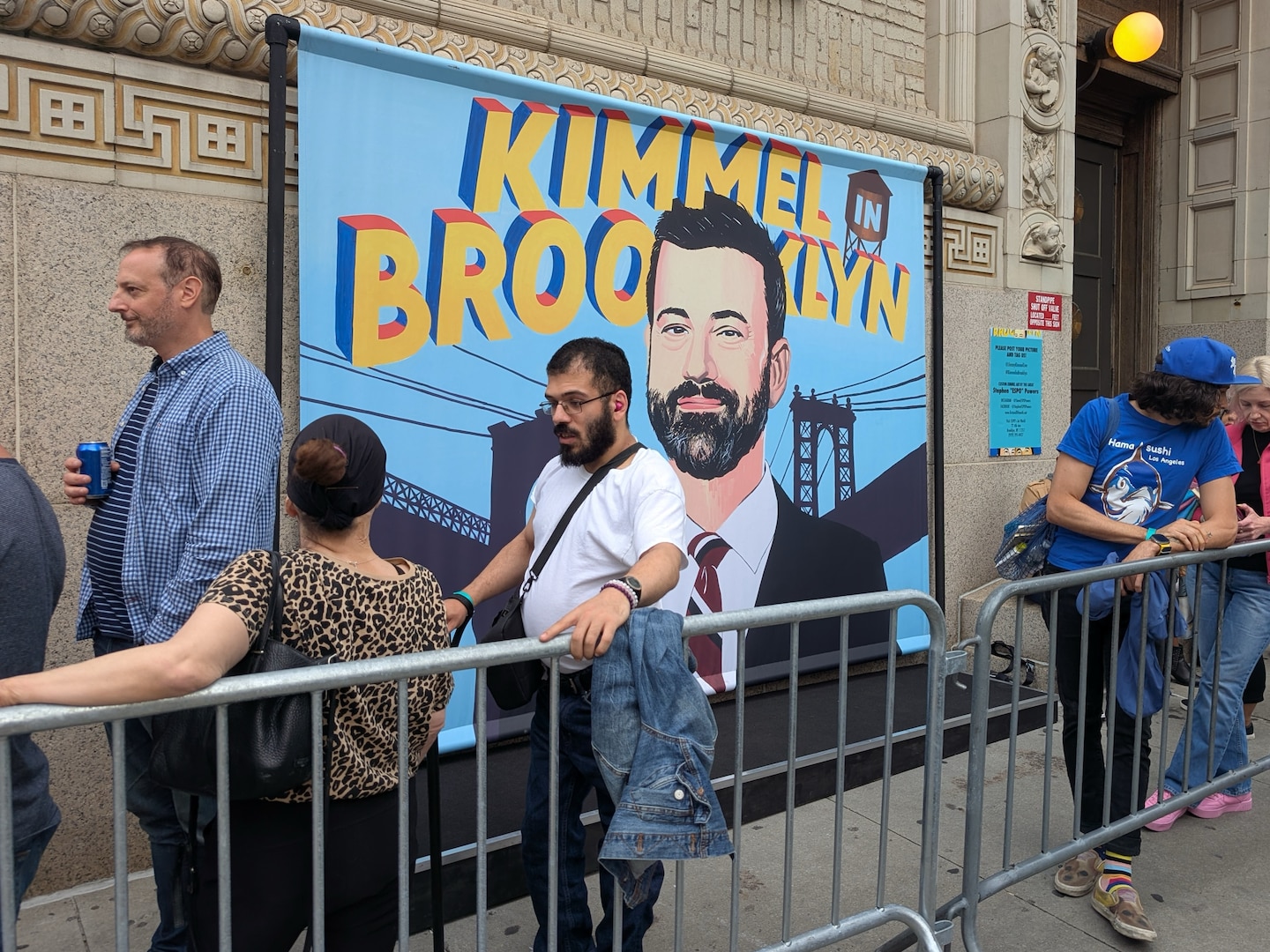The lights dimmed at the Kings Theatre in Brooklyn, and the crowd erupted as Jimmy Kimmel stepped onto the stage of his childhood borough. This wasn’t just another remote broadcast—it was a homecoming wrapped in vindication, marking a pivotal moment in late-night television history.
The Journey Back to Brooklyn
Jimmy Kimmel’s return to Brooklyn represents more than geographical nostalgia; it symbolizes a creative rebirth following one of the most challenging periods in his career. The comedian and talk show host, who grew up in the diverse neighborhoods of Brooklyn before eventually making his mark in Hollywood, brought his show back to his roots for a special week-long series of broadcasts.
The decision to film in Brooklyn wasn’t arbitrary. Kimmel has often spoken about how his Brooklyn upbringing shaped his comedic sensibility, giving him the street-smart wit and relatability that has made “Jimmy Kimmel Live!” a late-night staple for over two decades. The borough’s working-class ethos and multicultural fabric provided the perfect backdrop for what many are calling his most authentic performances in years.
The Suspension That Changed Everything
To understand the significance of this Brooklyn week, we must examine the events that led to this moment. Earlier this year, Kimmel faced a controversial suspension from ABC following undisclosed circumstances that sent shockwaves through the entertainment industry. While the specific details remain largely confidential due to legal agreements, industry insiders suggest the suspension stemmed from creative differences and network politics rather than personal misconduct.
The suspension period proved to be a transformative time for Kimmel. Rather than retreat from the public eye, he used the hiatus to reconnect with his comedic roots, perform at smaller venues, and develop material that would eventually inform his triumphant return. This forced break from the nightly grind of television production allowed him to gain perspective on his career and the direction of late-night television as a whole.
A Hero’s Welcome in the Borough
The Brooklyn audiences didn’t just welcome Kimmel back—they celebrated him. Each night at the Kings Theatre, crowds lined up hours before showtime, many traveling from across the tri-state area to witness what felt like a historic television moment. The energy in the theater was electric, with local references and Brooklyn-specific humor landing with the kind of authentic connection that’s often missing from Los Angeles-based productions.
“When I say ‘Jimmy,’ you say ‘Kimmel!'” became the rallying cry that opened each show, but it represented something deeper—a community embracing one of their own who had faced adversity and emerged stronger. Local politicians, including Brooklyn Borough President and several city council members, attended the broadcasts, treating them as civic celebrations rather than mere entertainment events.
The shows featured a mix of local guests, from Brooklyn-based business owners to neighborhood heroes, alongside traditional celebrity interviews. This format created a unique television experience that felt both intimate and grand, capturing the essence of Brooklyn’s community spirit while maintaining the production values expected of network television.
The Broader Impact on Late-Night Television
Kimmel’s Brooklyn week arrives at a crucial moment for late-night television. The genre faces increasing competition from streaming platforms, podcasts, and social media content creators. Traditional late-night shows have struggled to maintain relevance with younger audiences while preserving their established formats and advertising models.
However, Kimmel’s approach during these Brooklyn broadcasts suggests a potential evolution for the format. By embracing location-based storytelling and community-focused content, he demonstrated how traditional late-night television can adapt without losing its core identity. The success of these shows may influence other hosts to explore similar approaches, potentially revitalizing a format that critics have declared stagnant.
The ratings for the Brooklyn week exceeded expectations, with the Thursday night broadcast achieving the highest numbers for “Jimmy Kimmel Live!” in over two years. More importantly, the demographic breakdown showed increased engagement among younger viewers, suggesting that the format resonated with audiences who had previously turned away from traditional late-night television.
Industry Reactions and Future Implications
The entertainment industry has taken notice of Kimmel’s successful reinvention. Fellow late-night hosts Stephen Colbert and Jimmy Fallon both acknowledged the Brooklyn week’s impact during their own shows, with Colbert joking that he might need to return to his Charleston roots for inspiration.
Network executives are reportedly studying the Brooklyn broadcasts to understand what made them so successful. The combination of authentic local connection, elevated production values, and Kimmel’s renewed creative energy created a template that could be replicated in other markets and by other hosts.
Behind the scenes, the success has strengthened Kimmel’s position at ABC. Sources within the network suggest that the suspension, while painful at the time, may have ultimately benefited both parties by forcing a creative reset that has reinvigorated the show’s prospects.
The Cultural Significance
Beyond entertainment value, Kimmel’s Brooklyn week carried cultural weight. In an era of increasing geographic and cultural polarization, seeing a major television personality return to his working-class roots and celebrate his community resonated with audiences nationwide. The broadcasts showcased Brooklyn’s diversity and resilience while avoiding the stereotypes and caricatures that often define how media portrays outer borough communities.
Local business owners reported increased foot traffic during the week, with tourists and fans visiting locations mentioned on the show. The economic impact, while modest, demonstrated how television can still serve as a powerful platform for community promotion and cultural celebration.
Looking Forward
As Kimmel prepares to return to his regular Los Angeles studio, the question remains whether the lessons learned in Brooklyn will translate to his ongoing show format. Early indications suggest that elements of the Brooklyn approach—increased focus on community stories, more diverse guest booking, and a willingness to acknowledge his own vulnerability—will become permanent fixtures of “Jimmy Kimmel Live!”
The success of the Brooklyn week has also sparked discussions about potential annual homecoming broadcasts, creating a tradition that could become a signature element of Kimmel’s late-night legacy. Such events could provide regular opportunities for creative renewal while maintaining connections to the communities and experiences that shaped his comedic perspective.
Key Takeaways
- Authenticity resonates: Kimmel’s genuine connection to Brooklyn created television that felt both personal and universal
- Community engagement matters: Focusing on local stories and personalities enriched the traditional late-night format
- Adversity can inspire creativity: The suspension period allowed for reflection and artistic growth that enhanced the eventual return
- Late-night television can evolve: The Brooklyn week demonstrated new possibilities for a format many considered stagnant
- Location-based broadcasting works: Taking shows on the road can create unique content and stronger audience connections
- Ratings success validates innovation: The strong viewership numbers prove audiences hunger for fresh approaches to familiar formats
Jimmy Kimmel’s Brooklyn homecoming represents more than a successful week of television—it’s a case study in resilience, authenticity, and the power of community. As late-night television continues to evolve in response to changing media landscapes and audience expectations, the Brooklyn broadcasts may be remembered as a turning point that showed how traditional formats can reinvent themselves while staying true to their core mission of entertaining and connecting with audiences.

Born and raised amidst the hustle and bustle of the Big Apple, I’ve witnessed the city’s many exciting phases. When I’m not exploring the city or penning down my thoughts, you can find me sipping on a cup of coffee at my favorite local café, playing chess or planning my next trip. For the last twelve years, I’ve been living in South Williamsburg with my partner Berenike.

